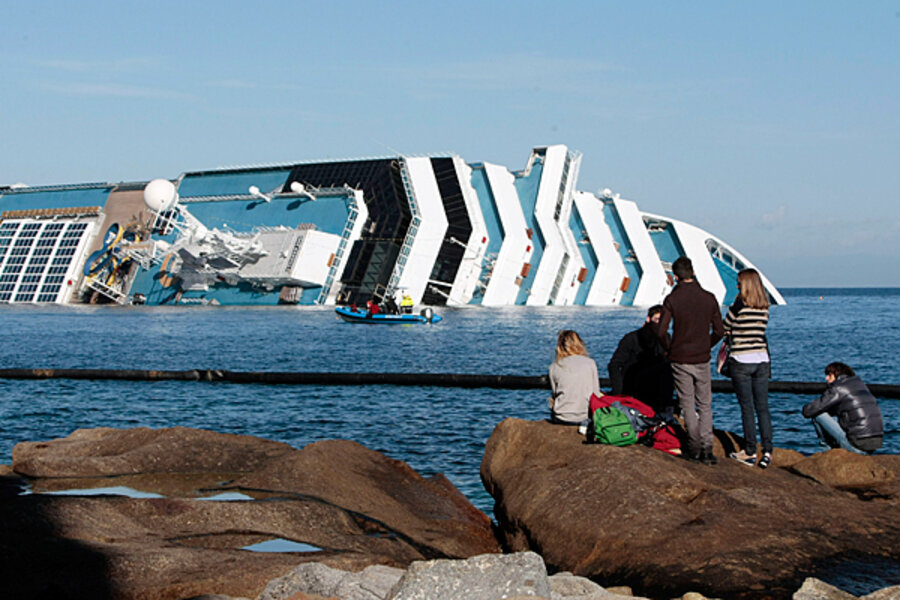Costa Concordia wreck: What we know a week later
Loading...
| Paris
A week after the Costa Concordia sank in shallow water two hours into a holiday cruise, transfixing the world, attention is now focused on the behavior of the captain before and after the ship hit a rock formation at 9:40 p.m.
What began as a serious tragedy off the Tuscan island of Giglio may now have some serious tabloid elements to the story.
New questions involve the role of a 25-year old blonde Moldovan, a Filipino cook, the captain’s alcohol intake, a dinner ordered after the collision, and the captain’s moves after the ship ran aground, leaving a 160-foot gash in the hull.
Captain Francesco Schettino seems to have been attentive to Domnica Cemortan, alternately described as a hostess and a dancer, for much of the evening before, during, and after the ship hit the rock, possibly dining with her as late as 10:30 p.m. The two were also together as late as midnight, according to Ms. Cemortan, at a lifeboat station, where he ordered her to leave the semi-submerged ship.
What was clarified this week: After charting an alternate course to sail closer to Giglio Island – a course that Costa Cruises denies it authorized – Schettino told investigators he “turned too late” to avoid rocks that some maritime experts say are uncharted but do show up on other nautical charts. In one animated mapping using nautical GPS positioning of the Concordia, the back half of the ship is shown grazing what is described as an exposed rock.
Transcripts of radio conversations between the Coast Guard and Schettino confirm that he left the ship while hundreds of passengers were still onboard.
In upcoming days, an accurate timeline may emerge of Schettino’s precise movements between the restaurant and the bridge as well as who he called and consulted – facts that are still murky and confused right now. The details have serious legal implications and consequences for insurance and recovery of the $450 million ultra-modern vessel.
Today rescue workers said the 117,000 ton Concordia is shifting on the ocean floor by 1.5 centimeters an hour, delaying additional rescue efforts and attempts at removing the oil onboard. Relatives of the 11 dead and 21 still missing are arriving from Peru, India, and European nations.
Building a timeline
Between 9 p.m. and 10:50 p.m., Schettino and Ms. Cemortan, who works for the cruise line but was not employed for the cruise, were seen eating and drinking together. The two were caught on an amateur camera at 9 p.m. in a ship restaurant. Cemortan, who gave an interview to a Romanian paper Thursday, said she was dining with Schettino at 9:30 p.m., around the time the boat hit the rocks. Rogelio Barista, a ship cook, told Manila TV he was befuddled by orders from the captain at 10:15 to serve food, including dessert, to Cemortan.
"I have had 12 years of experience as a cook on a cruise ship,” Mr. Barista said, in comments translated by CNN. “I have even witnessed fires, so I wasn't that scared. But I did wonder, though, what the captain was doing ... why he was still there."
Moreover, in what is generally an industry taboo, Schettino consumed at least part of a decanter of wine, according to Italian passengers who saw him in the restaurant.
William Wright, a British sea captain interviewed on Sky News today, said that just as commercial air pilots are forbidden to drink within a certain time frame of flying, so are ship captain eight hours prior to a voyage. Drinking on board by ship captains is “absolutely unacceptable” and there is a “zero tolerance” policy, Mr. Wright said.
Tapes indicate the Concordia did not make the call to abandon ship until more than an hour after the collision. The initial warning of danger came from a cell phone call by a passenger to a relative on shore who alerted the Coast Guard. It appears that ship communications with the Coast Guard deliberately hid its plight by presenting the crisis as an electrical blackout.
New tapes show that in the meantime, chaos ensued. The crew initially told passengers the problem was an electrical malfunction, then told them to don their lifejackets and head to lifeboat stations, but tapes show that passengers were later told to return to their rooms.
“We have a message from the captain,” says a crew member to passengers in a corridor in a video released Thursday. “We kindly ask you to return to your cabins, or go for a walk if you like. We’ll resolve the electrical problem that we have with the generator. I’m kindly asking you to go back to your rooms, where you’ll be seated and tranquil.”
Cemortan, who has so far not explained why the captain was so attentive to her under such extraordinary conditions, has defended Schettino, echoing his initial story that his maneuver of the ship to shallow water saved thousands of lives and that he was not one of the first to leave.
What Schettino himself told investigators is that he tripped and fell into a lifeboat accidentally while trying to help others. What remains unexplained is how he landed in the same lifeboat as the No. 1 and No. 2 next ranking Concordia officers.
“Seems quite amazing both for myself and other people,” said Mr. Wright, the British captain. “But we need to see the investigation.” The cruise liner was commissioned in 2006 and is one of the largest cruise vessels in the Carnival fleet.







